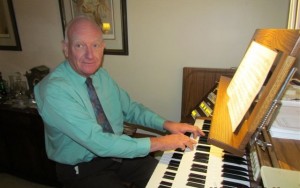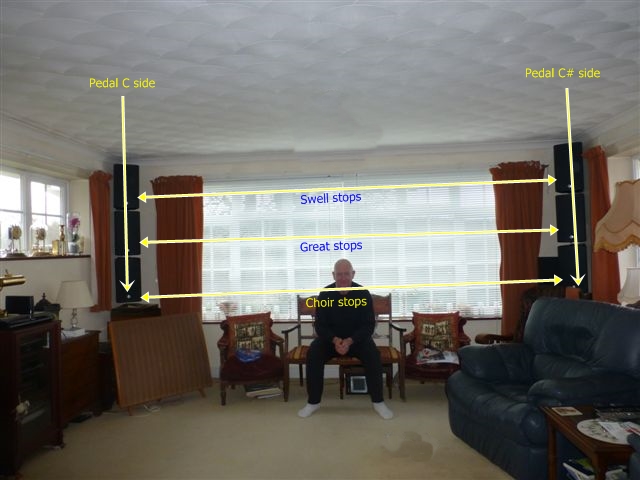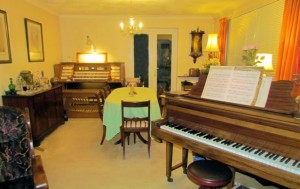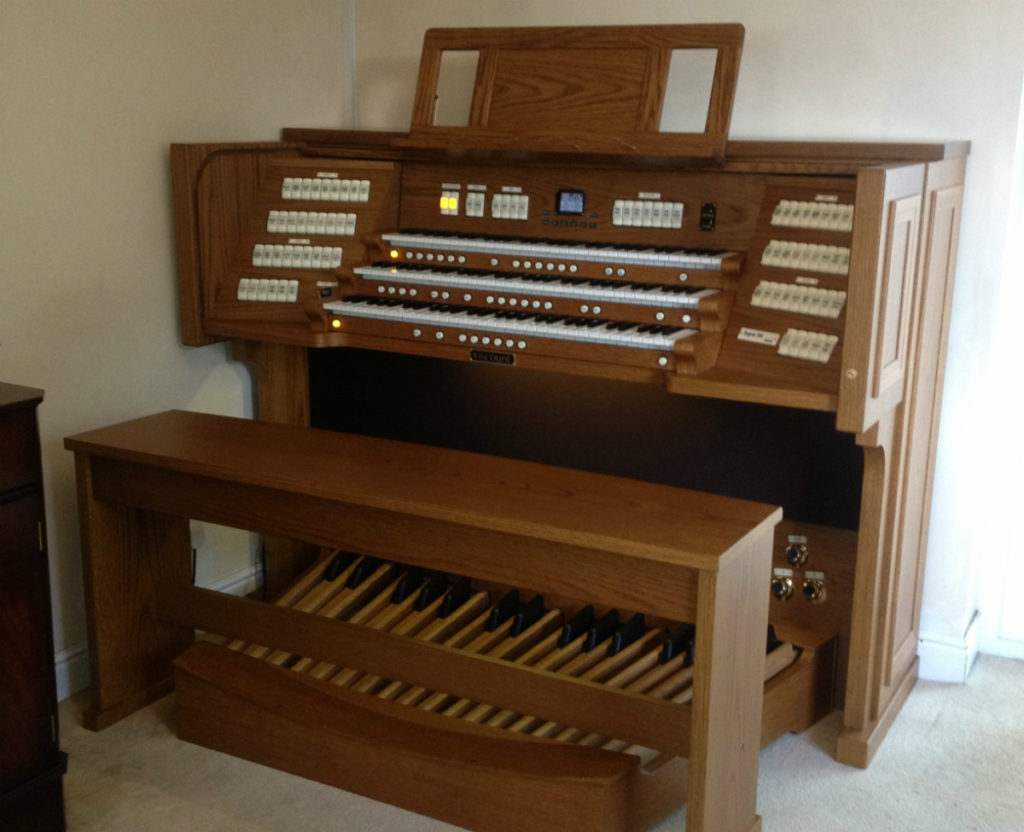Tony would be delighted to welcome organists contemplating the purchase of a Viscount to explore his home installation. If you are interested to do this please first call Viscount to be given Tony’s contact information.
 ‘I have wanted for some time now to share with others my experience in purchasing a new organ for my home use. I was concerned that any such attempt should not be interpreted as over enthusiasm for a particular supplier rather than well-informed decision made on my part. I hope I have achieved this.
‘I have wanted for some time now to share with others my experience in purchasing a new organ for my home use. I was concerned that any such attempt should not be interpreted as over enthusiasm for a particular supplier rather than well-informed decision made on my part. I hope I have achieved this.
What sort of organ do I want? Well I wanted one that sounded, touched and felt just like a full-size pipe organ that I have had the privilege to play and experience a few times in my life. I wanted a wide range of stops but also had a liking for the many schools of music and resulting organ designs and voicing. I wanted three manuals and a full-size pedal board. I wanted the normal playing aids you find on a larger instrument such as toe and thumb pistons.
The first stumbling block was the limitation of the packages provided by suppliers. I would find an instrument that had enough stops and playing aids but if I wanted internal speakers then I had to choose another range. If I finally accepted a model with external speakers then there were generally none in the console so I had to have enough external ones to do a reasonable job. I then found that I was frequently required to have a certain number of speakers regardless of the space I had. I was offered a compact solution where the entire speaker units could be compressed into fewer cabinets but this had the problem of acoustic interference between the different speakers and a restricted sound picture.
I wondered why I could not plug and play and get an organ that fitted my requirements but had a better price.
On a whim of fancy I contacted Viscount and did not expect other than the standard answers that I had elsewhere. To my surprise my initial questions were all answered with “yes we can do that”.
I now realise that the Viscount range of organs gets as near as it can to buying a custom model but off-the-shelf. This is why the cost can be so attractive and you can buy one instrument and get it to do all that you want rather than having to compromise with just one from a range of models or resorting to a custom-built one.
So what is so special about the Viscount range of organs especially within the Regent range? Yes you have the typical four different voicings as with other suppliers but when you ‘open the box’ you immediately find you’ve got so much more. For each voice the organ comes with a range of up to 40 alternative voices per stop. If that’s not good enough for you then you can change the voicing of each of those stops infinitely. You can alter the scale and make it stringier or more like a flute. You can vary the wind pressure, attack and you can vary the way the reeds speak. You can vary the way the organ responds to multiple pipes speaking on the same wind chest.
Does this configurability then have more surprises up its sleeve? I could not believe it because it most certainly does. We are all familiar with looking at the visible display pipes that decorate organ casework. Often you start with large pipes reducing to small in the middle rising to big pipes at the edge, refereed to in Viscount’s displays as a cusp layout. The cusp can be inverted and even be a double one. Quite common in concert halls are rows of pipes tapering from one side or the other. In any organ these pipes and the chest they are mounted on can be set at different heights above the ground. Pipes such as fanfare trumpets are often mounted in a particularly dominant position generally centre of organ. Would you believe it with whatever speaker setup you’ve got you can create these spatial effects above with surprising ease for every stop of the organ?
 In my case speakers are set up in simple stereo pairs stacked three high and when you set up a typical cusp the sound of each pipe moves in a picture created between the two chosen speakers just as you would experience standing in front of a rank of pipes.
In my case speakers are set up in simple stereo pairs stacked three high and when you set up a typical cusp the sound of each pipe moves in a picture created between the two chosen speakers just as you would experience standing in front of a rank of pipes.
So what of the sound it produces? Yes without this being good all of the tailoring above would be worthless. I will explain below why this sound production is so good through state-of-the-art technology.
In my time I’ve owned a pipe organ, a Compton organ with tone wheel sound generation in the early 60s and from the 70s a second-hand electronic church organ with sounds produced by all sorts of circuitry including oscillators and sound varying circuits.
I had watched with interest the emerging world of digital organs but had not really understood these as much as perhaps I should. Almost all manufacturers rely on sound sampling or CD like clips of sounds from individual stops. To make the organs affordable the sound clips are often kept very short and therefore repeated as notes are kept pressed. These clips are reused for different pitches through in built technology. The sound is therefore arguably not very lifelike. Just like going to a concert hall to hear an orchestra play a piece of music and then have the conductor switch on a CD which gives you the same performance each time. On a pipe organ if two pipes are played at the same time on the same wind chest as opposed to a single pipe being played then the resultant sound is subtly different every time. On sound sampled instruments the sounding of any one pipe will be pretty much the same whether played singly or in combination and other pitches derived from the same source will sound basically the same.
So what makes the Viscount so special? Well instead of the sound being canned, a physical model is held enabling each pipe to be recreated as if it existed. It is this model that is then edited to create the sound of individual pipe families. The resultant sound from many such pipe models then emulates exactly what a pipe organ would do with many pipes on the same wind chest. The only way Viscount could go any further would be to use the physical model to drive engineering equipment to produce the pipe and then put wind through it but then the cost would be horrendous just like a pipe organ.
Euphemistically modern pipe less organs are generally referred to as digital. To therefore refer to a Viscount organ as being simply digital is about as misleading as referring to a Dyson vacuum cleaner as a hoover.
As a result of the sound being produced on the spot combined with the ability to route the sound to the best combination of speakers gives clarity of sound that I have not found matched. The brilliance of that sound from the softest and most delicate flutes to the most brilliant and strident of reeds must be heard to be believed.
Bach supposedly said the most important stop on an organ is the building or room as the American’s say. So what can the Viscount offer? What is called rather misleadingly named reverberation in the set-up menu is there to surprise you. Even this is configurable from the blandest Chapel via a Basilica to a massive Cathedral. Even the dryness of the echo can be altered to emulate sound bouncing around a lofty and capacious building with the inevitable delay in the sound reaching the ear.
So again the tailor-ability of the Viscount range means you can have almost any organ you want in any building supplied off-the-shelf and set up on site to your requirement. From a basic range of three models giving rocking tablet stops, simulated drawer stops or full motorised stops you only then have to choose the number of manuals and off you go. This is why the prices are so good as from one simple range you can create almost any organ you want rather than choose one from the many ranges or limited ranges other suppliers provide. You can have whatever combination of speakers you want including massive bass one’s if your budget and space allows. All of your settings and recordings can be archived and stored on external media. In the unlikely event you ever get tired of the current setup either you as the user or the supplier can come in and change it for you. The instrument can be upgraded or actually reduced in size should you wish for whatever reason. More speakers can be added and any enhancement realised by the manufacturing factory is sent out as a free upgrade enabling you to keep up with the state-of-the-art and no further cost.
The price of any solution may to some seem almost too low and especially to churches where they are perhaps conditioned to expect to pay much more. The well designed and simple range is totally computer software driven and tailorable to meet almost any requirement and at any time upgradeable so consequently this brings the cost down considerably. You do not have to choose a model that gives you what you want, you choose what you want and the model can be configured to give you what you want and at the right cost’.
Tony A home customer in Berkshire January 2014.
Tony has now posted a clip on You Tube. You can find it here http://www.youtube.com/watch?v=JIx5Ar3up7A



